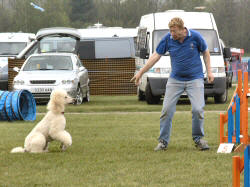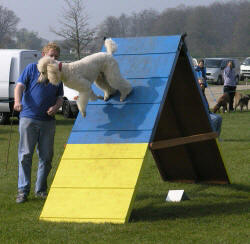 Agilitynet
wanted someone to write an article about a currently talking point in agility today - someone
with flair, someone with charisma, a certain someone who could, shape and sculpt words into
magical masterpieces. We wanted someone who could capture everyoneís imagination and change the
future of how we think as mortal humans. But, as Alan Disbery has retired, we settled for Lee
Windeatt. And so here is his controversial article on training in the ring.
Agilitynet
wanted someone to write an article about a currently talking point in agility today - someone
with flair, someone with charisma, a certain someone who could, shape and sculpt words into
magical masterpieces. We wanted someone who could capture everyoneís imagination and change the
future of how we think as mortal humans. But, as Alan Disbery has retired, we settled for Lee
Windeatt. And so here is his controversial article on training in the ring.
Some people call training in the ring putting your dog back on the
contact (touchpoint) after it has either missed it in competition or come off without a
release. Others call it training if you stop your dog on the contact for too long. It's my
opinion that we should all train our dogs in the ring in competition.
Watch the people at the very top, the ones winning tickets in
champ classes each week. The majority will train some of the runs that arenít qualifiers. Some
will stop their dog on the contacts for just a good solid contact, while others will stop for a
few seconds. Then, in an important run, they will run their contacts with more certainty that
the dog will run to the bottom as it's released, getting a good running contact. Dogs do know
the difference between competition and training, but if you start out training them in
competition at least you can fool them for a while.
How many times do we see someone with a promising youngster (pup)
enter the first few shows and run the dog off the contact like its going to electrocute the
dog. They win the dog into senior after a month and are then never heard of again? The dog has
learnt for the last six months it stops on contacts in training but at shows we run off them or
jump off as quick as we can. A 20 month old dog is not ready mentally to tackle Senior courses
and, if it is, then the trainer has probably done too much with it too soon.
 Every
dog - okay nearly every dog - misses a contact in its career. I have seen one dog miss four in
one class when they only had three contacts. The dogs that continually jump or fly the contacts
should be pulled out of agility and stick to just jumping classes only. The contact is there
for the dogs safety. Not much science behind it, but years ago they decided that if the dog
kept jumping off dog walks, A-frames from great heights then they would be likely to damage
themselves, either over a period of time or a one off... splat! So teach your dog that in
competition they sometimes stop and arenít allowed to get off the contact until they hear go.
Stop the dog for a second or five seconds. Vary it so the dog is guessing all the time and has
to wait for the... go command. Lay a good foundation for the dogís future contacts and when you
fancy winning the class, you will have more reliable, solid contacts. Well, that's the theory,
at least.
Every
dog - okay nearly every dog - misses a contact in its career. I have seen one dog miss four in
one class when they only had three contacts. The dogs that continually jump or fly the contacts
should be pulled out of agility and stick to just jumping classes only. The contact is there
for the dogs safety. Not much science behind it, but years ago they decided that if the dog
kept jumping off dog walks, A-frames from great heights then they would be likely to damage
themselves, either over a period of time or a one off... splat! So teach your dog that in
competition they sometimes stop and arenít allowed to get off the contact until they hear go.
Stop the dog for a second or five seconds. Vary it so the dog is guessing all the time and has
to wait for the... go command. Lay a good foundation for the dogís future contacts and when you
fancy winning the class, you will have more reliable, solid contacts. Well, that's the theory,
at least.
I also see people still blitz their contacts after they have
knocked a pole or been faulted in someway. Trust me, you arenít going to win the class and
probably wonít get placed so stop it on those contacts if you have any during the rest of the
run.
Now to judges...
I can hear all those judges that donít like 'training in the ring' swearing and
calling me names now. Well I canĎt find it in the rulebook anywhere that says we canĎt do this.
Okay without the judgeís permission, we arenít allowed to place our dog back on a contact but
we can stop them on it and wait a second or two. Some judges eliminate for this - no idea why -
usually 'cos their own dog doesnít stop on them. Ouch! Come on judges, admit it's true! At what
point they decide itís training, I donít know. If you stop your dog for 0.5 seconds or two
seconds when does the switch in their brain say it's a big 'E' for training in the ring? In FCI
rules I believe - not too sure though - that if your dog comes to a stop anywhere on the course
its five faults but thatís not our rules!!
It doesnít matter if the judge eliminates you as you arenít trying
to win the class or go for a decent place so who cares anyway, but the judge still has to watch
you for the rest of the run so donít let them turn their back on you afterwards. We still want
the dog to think its competition. If they do ask you to leave the ring , just shout abuse and
call them nasty names... okay, maybe not. Just accept it and mumble stuff under your breath.
Now to the nice judges, the sensible ones that let you put a dog
back on the contact or train in the ring. What they are doing is making sure the dog learns it
canít shoot off the contacts from great heights and help preventing the dog from future
accidents, incidents or damage to its own body. What nice judges these are. Can we have more of
them please?
I do think judges should have permission to ask someone to leave
the ring if their dog jumps from the top of two pieces of contact equipment risking injury.
Perhaps they already do have permission but donĎt use it. Some judges find this acceptable and
they let a dog with no control fly the touch points, stay in the ring and yet someone who is
trying to teach their dog control and keeping them safe to leave the ring. Strange logic.
I do realise that by everyone stopping on the contacts that we are
using up more of the judges time and will probably cause the show to go on longer but there is
nothing on TV on Saturday or Sunday nights anyway. I do judge and, whenever you are in my ring,
you may train your contacts or place your dog back on the contact as long as you don't abuse
the time or harsh handle in any way.
 About
the author...
About
the author...
Lee Windeatt has been
doing agility since 1999. His first agility dog called Kiss died when she was four of kidney
failure. After that, he got Shy and Bold. Shy will soon be four and is working Advanced but is
far too slow and too old to ever win according to Mr. Munnings. Bold is two years old and the
prettiest dog in agility. Everyone thinks he is a girl. He runs like a lamb and has recently
gone Senior.
Lee's favourite pastime, other than training, is winding people up
on The Agility Forum.
Feedback
From Yvette Curtis...
I found the article very interesting. Having a young dog who has just started competing, it
didn't occur to me until a few shows ago that what I was doing what could be deemed as training
in the ring. I always, in training hold Skate on the contacts for a count of maybe two or
three, then tell him what a good boy he is and then release him. I decided without thinking
that I would do this in the ring, so I have been holding him for a count of two, maybe three,
then the release. It suddenly came to me in an Intermediate class that it could be seen as
training. After asking a few people, they said I have been very lucky. I have not been ejected
from the ring, I was then scared and started to release him quicker to me. This is not really
acceptable. I want to treat the ring the same as training and, although not physically putting
him back on contacts as he does not usually come off them, I want him to think that he does not
move until told to. I have already noticed that he has started to come off the a-frame before
the okay so back to the hold for a few seconds it is to be.
I also judge and I let people train, within reason, on the contacts. As said in
Mr. Windeatt's article, no point teaching one thing in training and another in the ring. What
is the harm? There is no harsh handling or shouldn't be. That is a different matter so what is
the harm in teaching the dog to negotiate the obstacles in a careful, controlled manner. There
are far too many dogs injured these days. And no it does not say, to my knowledge, in the KC
rules that there should be no training in the ring.
Probably get lynched now or asked to leave the ring next time I am counting my
two or three seconds. Anyway thought I would say what a well written article and how much I
agree with what has been said. (30/08/06)
From Jackie, Rocky & Stormy's Aussie Posse, Lady
Bug, O.D. & Itty Bitty Too!
Read your article about, 'Training In The Ring.' I don't
know if you are familiar with NADAC here in The States. They allow training in the ring under
these conditions. You tell the judge before you start your run or you tell the judge while
running your dog - usually after you know you have already been NQ'd (eliminated). This way you
can correct the problem. You are nice to your dog. Don't let your dog do excessive repeats on
any one obstacle and last, but not least, once you say 'I'm Training,' you only get the maximum
SCT (course time) for that run, so you do not take up time you did not pay for that time in the
ring, and the judge can ask you to leave at any time. (28/08/06)
From Rachel Woods
I couldn't agree more with Lee. When I was a new handler,
in my enthusiasm, I allowed my then Midi to get away with missing contacts in the ring and it
has taken years to get him to accept that he has to get to the bottom. Needless to say with my
new girl, I are training very solid contacts and I will not hesitate to put her back on a
missed contact when we start to compete. What I think we ought to do though is then thank the
judge and leave the course - on the most direct route to the last obstacle to stop the timer.
As Lee states, if this does not exceed the course time (at least not by much) then I don't see
the problem. We all want the safety of our dogs to be paramount and we would all love those
dream contacts!
Any judge that finds this unacceptable should say so
during their briefing, thereby giving handlers the option to pull out rather than risk an iffy
or dangerous contact. Common sense from handlers would be more than welcome. There is nothing
more frustrating than being in a queue waiting for someone that has taken 3 times the course
time to coax a dog around that clearly doesn't want to run. I do believe in these cases Judges
should intervene. After all Agility should be enjoyable for both parties!
Well done Lee - an interesting topic. It's more
common sense than controversial!
 From
Richard Partridge
From
Richard Partridge
I was very interested to read Lee Windeatt's piece
regarding Training in the Ring. I have been exercising my brain on this matter for some time,
but in a rather wider context.
My start point is somewhat different though. Now, before the
comments about Johnnie-Come-Latelies from the old stagers start, I freely confess that we have
only recently - four years ago - started Agility, but in that time I have heard constant
grumbles about 'it's not the same as is was.'
I was not there in the old days so I don't know, but I suspect
that Agility, like life, does not remain the same. It's called evolution and if it were not for
this gradual change we would still be slugs!
What I am sure I have noticed though is that Agility is becoming
more popular and shows are attracting larger entries and thus bigger classes. I feel that a lot
of the grumbles in the queues are related to this, classes and shows sometime seem to go on
forever, even though, as Lee pointed out, we rarely have any other pressing appointments. It is
frustrating to have to sit around waiting for extended periods. It seems to me that we can made
the rings run more slickly fairly simply, and we can all help in certain ways.
Point one, and here is the training in the ring part.
As far as I'm concerned when you are in the ring you can do what you want within the rules, but
in your time, not everybody else's. I would suggest that when a dog is on the course for, say,
over 125% of the course time the scrimer could raise their hand to tell the judge. The judge
would then, at their discretion, be able to eliminate the dog and handler and send it out of
the ring by the shortest route. This applies not only to formal training but, in other cases,
we all see where both the dog and the handler are newcomers and phased and not covering the
ground, or where a dog, like ours, is fair enough in training but on the course becomes so
interested in what's going on around it that it trots around enjoying the spectacle, especially
from the top of the A-frame!
New comers to the sport (?) and new dogs need experience to
progress, and some of that experience can only we won in the ring, so let's have a framework
where this can be done but is fair to all. When our 'pudden' of a dog takes too much
time, I always pull him out, and make way for the next competitor, and I am sure that most
others, as long as they were aware of the convention, would as well. After all, how much
time do you really want being humiliated in public by man's best friend?
Point two
We can all make the class go faster with a little self-discipline. We all know that when we
get near the front of the queue it is time to stop chatting and to get ourselves and our dog
ready to run. We have all sometimes suddenly realised that we are next and been too busy
nattering to notice. The previous dog has finished and the judge is ready for us, but we still
have our coat on, the dog has his lead etc.
Another area where we can save time is to get the dog on the start
line while the previous one is running. At some shows a member of the ring party will tell
us 'to go to the line when the dog has passed no. 10' for instance. But, again probably due to
greater popularity, helpers are sometimes thin on the ground. Surely we all have the wit to be
able to work out a suitable point when we can go onto the course without disturbing the current
competitor.
Point three
Be nice to the ring party. I know that some individuals seem uncooperative, bolshy,
obstructive etc, but most are very pleasant and helpful. Don't forget they are freely giving of
their time and without them there would be no show. Remember also that they are helping, you
are probably not!
And most of all keep reminding yourself Agility is fun! Simply
don't spoil your day or let others spoil it. Life ain't perfect so why should we expect Agility
to be?